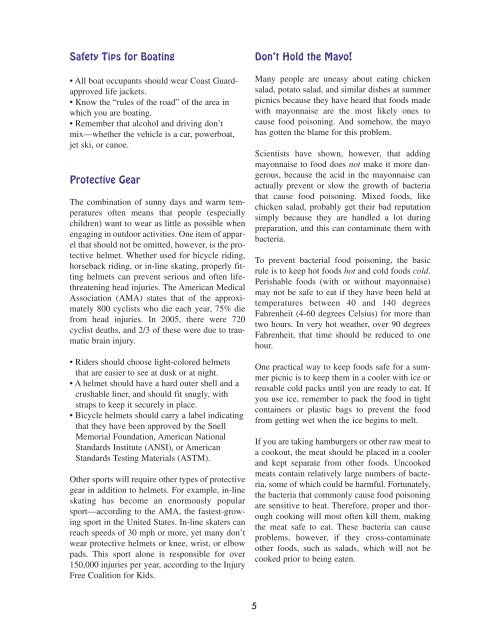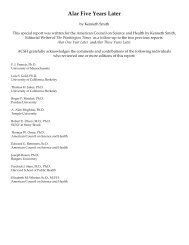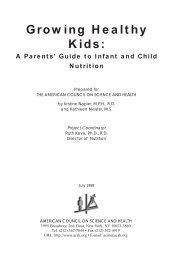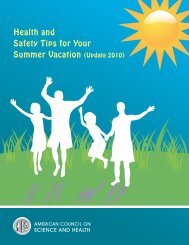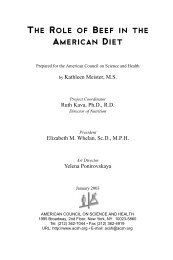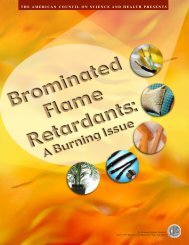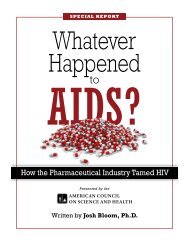View pdf - American Council on Science and Health
View pdf - American Council on Science and Health
View pdf - American Council on Science and Health
You also want an ePaper? Increase the reach of your titles
YUMPU automatically turns print PDFs into web optimized ePapers that Google loves.
Safety Tips for Boating<br />
• All boat occupants should wear Coast Guardapproved<br />
life jackets.<br />
• Know the “rules of the road” of the area in<br />
which you are boating.<br />
• Remember that alcohol <strong>and</strong> driving d<strong>on</strong>’t<br />
mix—whether the vehicle is a car, powerboat,<br />
jet ski, or canoe.<br />
Protective Gear<br />
The combinati<strong>on</strong> of sunny days <strong>and</strong> warm temperatures<br />
often means that people (especially<br />
children) want to wear as little as possible when<br />
engaging in outdoor activities. One item of apparel<br />
that should not be omitted, however, is the protective<br />
helmet. Whether used for bicycle riding,<br />
horseback riding, or in-line skating, properly fitting<br />
helmets can prevent serious <strong>and</strong> often lifethreatening<br />
head injuries. The <str<strong>on</strong>g>American</str<strong>on</strong>g> Medical<br />
Associati<strong>on</strong> (AMA) states that of the approximately<br />
800 cyclists who die each year, 75% die<br />
from head injuries. In 2005, there were 720<br />
cyclist deaths, <strong>and</strong> 2/3 of these were due to traumatic<br />
brain injury.<br />
• Riders should choose light-colored helmets<br />
that are easier to see at dusk or at night.<br />
• A helmet should have a hard outer shell <strong>and</strong> a<br />
crushable liner, <strong>and</strong> should fit snugly, with<br />
straps to keep it securely in place.<br />
• Bicycle helmets should carry a label indicating<br />
that they have been approved by the Snell<br />
Memorial Foundati<strong>on</strong>, <str<strong>on</strong>g>American</str<strong>on</strong>g> Nati<strong>on</strong>al<br />
St<strong>and</strong>ards Institute (ANSI), or <str<strong>on</strong>g>American</str<strong>on</strong>g><br />
St<strong>and</strong>ards Testing Materials (ASTM).<br />
Other sports will require other types of protective<br />
gear in additi<strong>on</strong> to helmets. For example, in-line<br />
skating has become an enormously popular<br />
sport—according to the AMA, the fastest-growing<br />
sport in the United States. In-line skaters can<br />
reach speeds of 30 mph or more, yet many d<strong>on</strong>’t<br />
wear protective helmets or knee, wrist, or elbow<br />
pads. This sport al<strong>on</strong>e is resp<strong>on</strong>sible for over<br />
150,000 injuries per year, according to the Injury<br />
Free Coaliti<strong>on</strong> for Kids.<br />
5<br />
D<strong>on</strong>’t Hold the Mayo!<br />
Many people are uneasy about eating chicken<br />
salad, potato salad, <strong>and</strong> similar dishes at summer<br />
picnics because they have heard that foods made<br />
with may<strong>on</strong>naise are the most likely <strong>on</strong>es to<br />
cause food pois<strong>on</strong>ing. And somehow, the mayo<br />
has gotten the blame for this problem.<br />
Scientists have shown, however, that adding<br />
may<strong>on</strong>naise to food does not make it more dangerous,<br />
because the acid in the may<strong>on</strong>naise can<br />
actually prevent or slow the growth of bacteria<br />
that cause food pois<strong>on</strong>ing. Mixed foods, like<br />
chicken salad, probably get their bad reputati<strong>on</strong><br />
simply because they are h<strong>and</strong>led a lot during<br />
preparati<strong>on</strong>, <strong>and</strong> this can c<strong>on</strong>taminate them with<br />
bacteria.<br />
To prevent bacterial food pois<strong>on</strong>ing, the basic<br />
rule is to keep hot foods hot <strong>and</strong> cold foods cold.<br />
Perishable foods (with or without may<strong>on</strong>naise)<br />
may not be safe to eat if they have been held at<br />
temperatures between 40 <strong>and</strong> 140 degrees<br />
Fahrenheit (4-60 degrees Celsius) for more than<br />
two hours. In very hot weather, over 90 degrees<br />
Fahrenheit, that time should be reduced to <strong>on</strong>e<br />
hour.<br />
One practical way to keep foods safe for a summer<br />
picnic is to keep them in a cooler with ice or<br />
reusable cold packs until you are ready to eat. If<br />
you use ice, remember to pack the food in tight<br />
c<strong>on</strong>tainers or plastic bags to prevent the food<br />
from getting wet when the ice begins to melt.<br />
If you are taking hamburgers or other raw meat to<br />
a cookout, the meat should be placed in a cooler<br />
<strong>and</strong> kept separate from other foods. Uncooked<br />
meats c<strong>on</strong>tain relatively large numbers of bacteria,<br />
some of which could be harmful. Fortunately,<br />
the bacteria that comm<strong>on</strong>ly cause food pois<strong>on</strong>ing<br />
are sensitive to heat. Therefore, proper <strong>and</strong> thorough<br />
cooking will most often kill them, making<br />
the meat safe to eat. These bacteria can cause<br />
problems, however, if they cross-c<strong>on</strong>taminate<br />
other foods, such as salads, which will not be<br />
cooked prior to being eaten.


